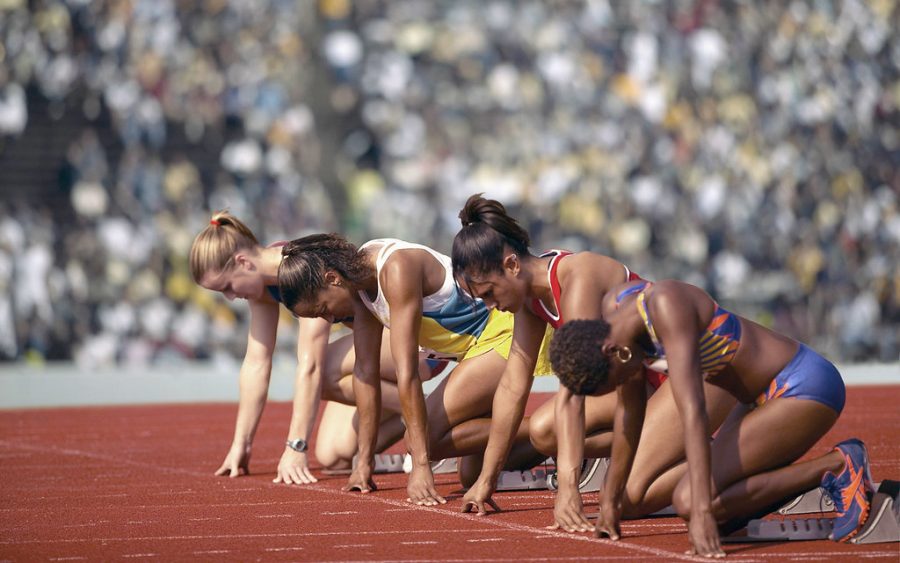Train like a girl: Why we need more studies focused on female athletes
Photo courtesy of Jupiterimages
Female track athletes at the starting line
Women are not small men, and you can’t “shrink it and pink it” anymore. Women have been poorly represented in sports science studies and research up until a decade ago, and the lack of inclusiveness doesn’t come without consequence.
For the longest time, women have been training identically to men with one small adjustment: less volume. This is due to the deficit of sports science knowledge specifically based on women and their training needs.
Among many reasons, researchers avoided the study of women because it simply wasn’t convenient. According to Outside, women are not only harder to study than men because of fluctuating hormones, but the efforts required to track and record the many factors that impact a woman’s training is far more expensive.
In her 2019 TED Talk, Stacy T. Sims, an advocate for gender equity in sports research, said that the few women who participated in studies with men skewed so far from the usual data that those results were disregarded as anomalies.
With limited gender-specific research for women, female sports programs are put at a disadvantage, not only in performance, but also in health and safety.
According to the US National Library of Medicine, in a study with non-pregnant women, women were more likely to develop anemia than men. Anemia is caused by iron deficiency and leads to fatigue and weakness due to the body’s decreased ability to carry oxygen through red blood cells. This can often occur in female athletes who aren’t consuming enough food with iron and leads to a decrease in athletic performance.
The amount of knowledge coaches have and can impart upon their athletes have a huge impact on the longevity of their career, and for women it makes all the difference for their coaches to understand the female body. Senior Emily DiSarno, who runs varsity cross country and track and field said, “I think that my coaches have some knowledge on training women specifically because they were the ones who encouraged me to get a blood test to see if I had anemia.”
According to Roar by Stacy T. Sims, women are more susceptible to certain health problems in athletes, such as Relative Energy Deficiency in Sports (REDS), ACL injuries and dehydration. Because of this, the importance of athletes being educated on injury prevention, proper nutrition and how to fuel for workouts in order to stay healthy and able to compete, is ever more present for women.
According to the Journal of Women’s Health, when women are ovulating, a hormone called relaxin is released causing ligaments and joints to loosen up, and relax the walls of the uterus in preparation for a baby. Additionally, women generally have wider hips, to permit childbearing, and both these factors cause more susceptibility to injury in general, and especially while ovulating. “I’ve seen a couple of girls tear their ACL while they are on their period,” said WHS Athletic Trainer Nicole Castellano.
Aside from just injuries, REDS, formerly known as the Female Athlete Triad Syndrome, is a harmful condition that women are prone to developing for a variety of reasons, mainly stemming from underfueling. This is far more common in women than men.
Castellano said, “Nobody teaches athletes in general what to do with nutrition and that could lead to Female Athlete Triad Syndrome. That is something that happens to athletes when they have poor body image and they lose a lot of weight and they are not eating correctly and they lose their period.”
Not only could poor education in nutrition put athletes at a higher risk for developing REDS, but there is less focus on educating female athletes on preventing conditions that they are more likely to develop. Sophomore Clare Logan, who swims at an elite level, said, “I have not heard of REDS and my coaches have not talked about it.”
Additionally, it is often seen as a negative for girls to have to train while on their period; both Disarno and Logan say cramps make it uncomfortable to train. Despite this, according to Roar, it is actually the most beneficial hormone phase for training, the low hormone phase, where women are the most resilient to fatigue, muscle soreness and recover more quickly.
The amount of information available to female athletes about their bodies, and how to take care of them both in and out of training can vastly impact their ability to develop as athletes. Training men and women according to the same methodology, with the same expectations for how they will respond, can lead to detrimental effects of gender bias in sports science research.
“It’s possible that a man and a woman with the same background and genetic profile in almost every way could undertake the same training approach, controlling for every variable except gender, and the man would become a world champion while the woman suffers from a major health crisis,” said David and Megan Roche from Trail Runner Magazine.

